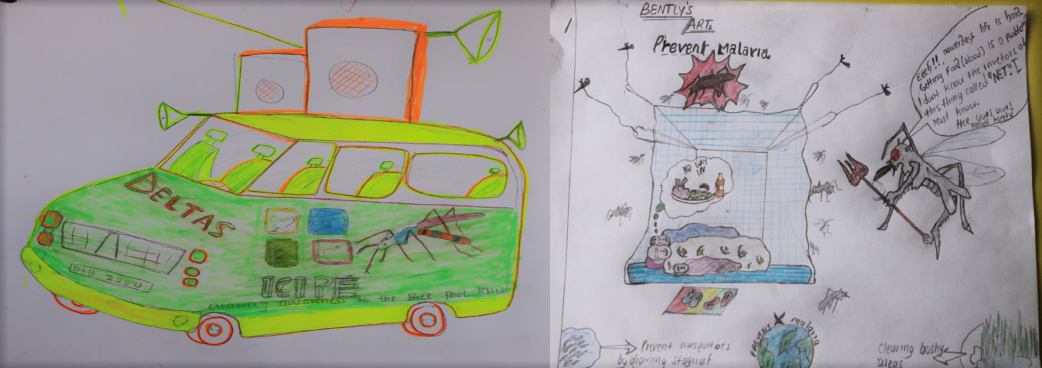
Trizah Milugo is a biochemist at the International Centre of Insect Physiology and Ecology (icipe). Her project was supported by the DELTAS Africa Community and Public Engagement (CPE) Seed Fund. In her research, she is working to develop new tools to reduce the transmission of malaria. At icipe, community engagement is used to increase the uptake and impact of their research in communities and to serve their capacity development efforts by engaging the youth in scientific research to generate future scientists, with the aim to develop a critical mass of young researchers from Africa in arthropod-related sciences.
In this article, Milugo describes her project, which aimed to promote malaria prevention practises among young people, enabling them to act as ambassadors and share this information within their communities and inspire them to consider a career in science.
Engaging young people as malaria ambassadors
Malaria is a life-threatening disease caused by the Plasmodium parasite and transmitted from human-to-human by the bite of female Anopheles mosquitoes that carry Plasmodia. The disease continues to be a leading health burden worldwide, despite concerted efforts to control it. Recent data show a global decline in new infections; however, in Africa, where the most infections and mortalities are reported, the decline is marginal, and compared to the rest of the world, current rates are persistently high. Consequently, most governments in malaria-endemic countries have embraced malaria elimination goals in their national strategic plans to fight malaria.
In Kenya, about 70% of the country’s 46 million people are at risk of malaria, with over a million cases and thousands of deaths each year. Significantly, the malaria burden is distributed disproportionately within the country, with those living in western Kenya most at risk. Malaria is also a leading cause of school absenteeism.
High school students can be powerful contributors to the community information cycle. Engaging them with information about malaria prevention and control will empower them to share this with their communities, to help reduce malaria transmission.
Trizah Milugo discussing her mentorship and training of High school students in Nyanza and Western Kenya about malaria on YouTube
The Sciback-skit Programme
The Science-based Conversation, Knowledge and Skill Transfer (Sciback-skit) programme was developed, with the main goal being to transform students into malaria ambassadors in their immediate and broader communities. The student’s interest in and existing knowledge of science and malaria prevention- and control-related activities was assessed by questionnaires and interviews. This made it possible to make connections between students interested in science and scientific literacy about malaria.
Sciback-skit was implemented in three high schools in western Kenya, the region with the highest malaria risk in Kenya. The schools were intentionally selected to ensure spatial and structural variation: A mixed day school; a mixed day and boarding school and a boys’ only boarding school.
The project aimed to promote science literacy among high school students in Kenya using multiple approaches: a learner-centred engagement approach, science-based demonstrations, and a student research competition.
Educating students about malaria and scientific research
The first stage involved educating the students about malaria, and it’s treatment and control and engaging them in career discussions.
The learner-centred engagement approach involved use of different tools such as one-on-one mentorship, career talks and administering questionnaires to reveal student interest in science and to gauge their knowledge of malaria. The questions asked about malaria symptoms and treatment, vector characteristics, malaria control and preventive measures, through multiple choice, rank order and open-ended questions. A career mentorship project was launched in November 2019 to support students as they develop their career competencies. The students were taken through career exploration, high school subject choices, managing career changes and other career-related issues.
Science-based demonstrations were used as an active and observational learning method to enhance science literacy in students. In this two-tier approach, students participated in hands-on activities and poster sessions. Activities included identification of mosquito species, understanding the mosquito life cycle and extraction of bioactive components of medicinal plants using organic solvents.
Arts and science competition
The second phase of the project sought to challenge the students to communicate the information they had learned during demonstrations and career counselling.
The project culminated in a student arts and science competition. The aim was to challenge them to communicate what they had learnt through this project about malaria prevention and control strategies, enabling them to then take this information into their communities. This approach is important as it can reveal the influence of individual experiences, the actions of others, and environmental factors on an individual behaviour.
The competition encouraged those with an interest in science to explore and showcase their projects. The performance arts segment featured an array of poems, spoken word presentations, traditional dances, modern dances, mimes, painting, puzzles, drawing, plays and narratives. Students were equipped with everything they needed for the projects and contests. The quality of scientific and artistic output was used as a metric for capacity building. Artistic expression was used to lay the groundwork for communicating scientific information on malaria through television, plays, and other forms of creative expression that provide opportunities to reach different audiences and to integrate malarial science more richly into the broader Kenyan culture.
 Artwork made by a student for the arts and sciences competition
Artwork made by a student for the arts and sciences competition
Key Findings
- There is a great need for career mentorship and counselling for high school students in rural areas.
- There is need to cover malaria information gaps in high school students in malaria-endemic regions because this demographic is a powerful player in the community information cycle. One of the participants exemplified this perspective: “We have been given knowledge on malaria prevalence and prevention and about sciences in general; how to go about them and how to pass them.”
- Kenyan high school students are talented and need a platform that enables them to apply knowledge and skills to life situations in their settings. Figure 1 illustrates this in a drawing from one of the students, demonstrating the need to use a public address system to educate the public on malaria.
Impact
A total of 402 students from three schools participated in the project. Interviews revealed that a majority of the students intended to pursue science-based courses at tertiary levels. Many of those who had shied away from participating were nonetheless willing to enrol in follow-up meetings.
In one of the schools, the programme T-shirt was officially incorporated into the school uniform, to be worn on Wednesdays during club activities. At the end of the assessment, both students and teachers in all participating schools felt that they were mentored, inspired and equipped for a paradigm shift to focus more on sciences. Further, most of the students are now more informed about basic preventive and control measures for malaria and able to share this information, e.g., use of insecticide-treated mosquito nets, proper drainage to reduce stagnant water, slashing of grasses and thickets and the need to seek medical advice whenever one shows malaria symptoms. This information is captured in some of the drawings by students as depicted in image above.
Overall, this community and public engagement project provided a great learning opportunity for both the researcher and the participants. We anticipate that it will contribute immensely towards public science literacy.
This report is part of the DELTAS Africa CPE Seed Fund Programme Hub
This work is licensed under a Creative Commons Attribution 4.0 International License


Please Sign in (or Register) to view further.